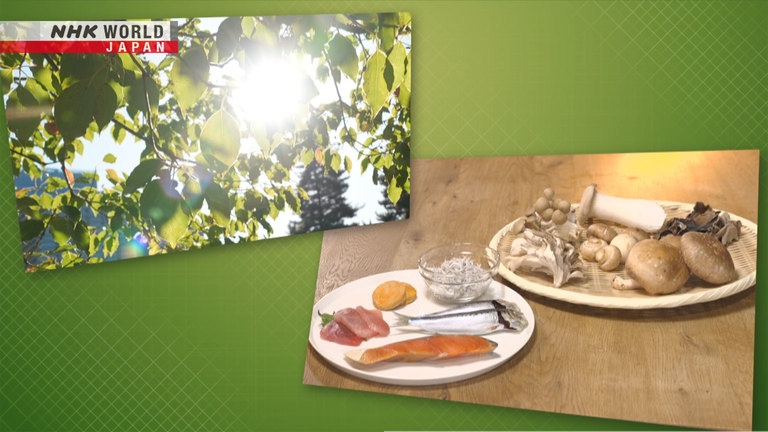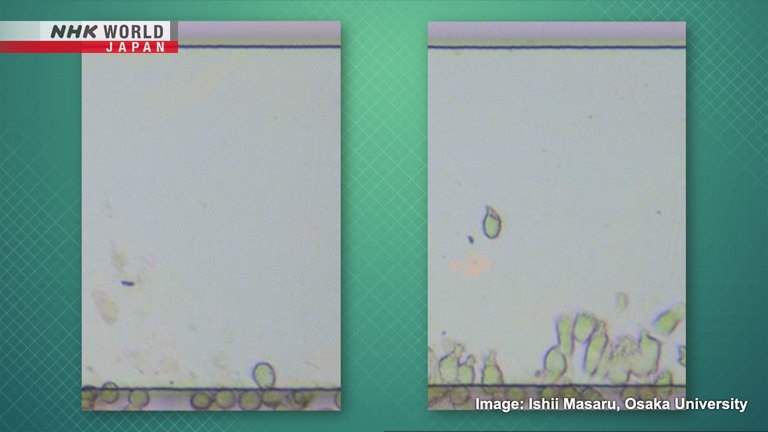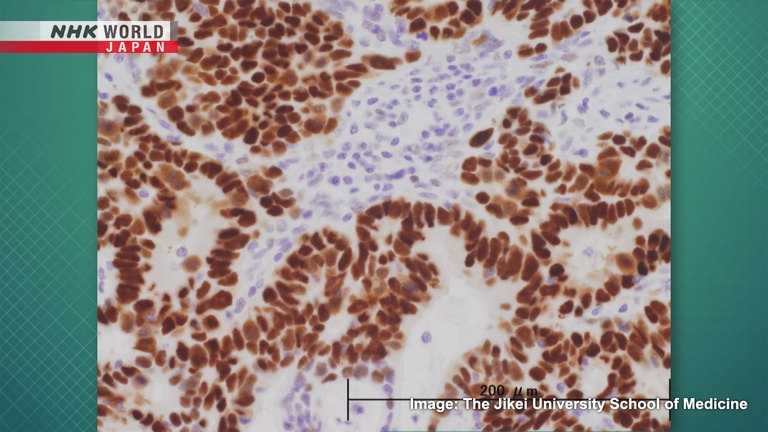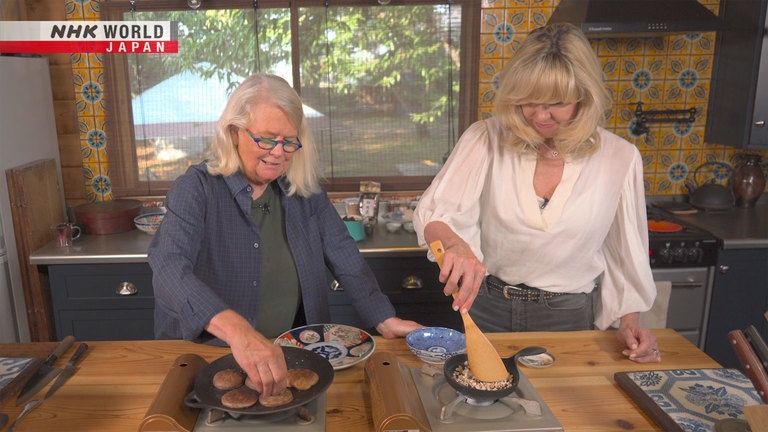The Power of Vitamin D: From Osteoporosis to Cancer
Japanese researchers have uncovered the mechanism behind vitamin D's bone-strengthening effects. Its potential impact on cancer is also becoming apparent. We explore the power of Vitamin D.




Transcript
Join us as we explore Medical Frontiers!
Vitamins are crucial for our health.
Among them, vitamin D is unique as it is produced when the body is exposed to sunlight.
While its role in strengthening bones has been known for quite some time,
there was limited understanding of the way it worked.
Japanese researchers uncovered the mechanism and captured unprecedented footage of the process.
Vitamin D is now attracting attention for its ability to raise survival rates among cancer patients.
In 2023, a study by another Japanese research team gained global recognition as a game changer for vitamin D and cancer.
Hmm... this feels so nice. I also try to bask in the sunlight whenever I can.
But how about you? Are you getting your daily dose of vitamin D?
Reports suggest that about 98 percent of Japanese don't have adequate levels of vitamin D,
and there are concerns that this may lead to a number of different health issues.
We are going to delve into the latest Japanese research to uncover the benefits,
significance and the potential of vitamin D.
The International Osteoporosis Foundation estimates that over 200 million people worldwide have the bone-weakening disease.
Osteoporosis occurs when bones become porous and fragile with age.
Bone fractures happen globally every three seconds.
In severe cases, patients may become bedridden and face complications.
Vitamin D is critical in maintaining healthy bones.
Thank you for your time.
To understand the effects of vitamin D on the body,
we spoke with Tsugawa Naoko, a director at the Vitamin Society of Japan.
What are the characteristics of vitamin D?
There are 13 kinds of vitamins,
with 4 being fat-soluble, including vitamin D.
Vitamin D raises the blood's calcium levels,
helping to regulate the calcium balance.
Calcium is a key component of bones, and
vitamin D helps to maintain bone strength.
So, how and where is vitamin D specifically made in the body?
There's a precursor substance
to vitamin D in the skin.
The vitamin can be produced anywhere on the skin.
Direct exposure to ultraviolet rays causes a change in a substance
found in the skin's outer layer, eventually converting it to vitamin D.
The vitamin then enters the body through tiny blood vessels known as capillaries.
Vitamin D is also contained in fish and other foods.
But regardless of its source, vitamin D does not function in its original state.
It undergoes a change in the liver, then travels in the bloodstream.
If needed, it goes through another transformation in the kidneys,
becoming activated before it can work on bones and other tissues.
For a long time, little was known about how vitamin D strengthens bones.
A breakthrough occurred through the efforts of a Japanese research team led by Ishii Masaru.
Osteoclasts break down old bone tissue,
while osteoblasts create new bone tissue.
The health of our bones relies on
a balance between these two types of cells.
So, how does vitamin D affect the balance?
Bones undergo constant regeneration.
Osteoclasts break down old bone, while osteoblasts repair and restore damaged areas.
However, this balance is disrupted by the various effects of aging.
When bone breakdown becomes dominant, bones turn increasingly weak and porous.
This is osteoporosis.
Using mice, Ishii captured footage of osteoclasts breaking down bone tissue for the first time in the world.
The blue areas are bone, and the red parts resembling amoebas on the bone's surface are osteoclasts.
The osteoclasts emit a glowing green acid as they break down the bone tissue.
We studied how osteoclasts arrive
at bones, and how they're formed.
We found that vitamin D might be involved.
Osteoclasts originate from macrophages -
immune cells that protect our health by consuming pathogens and other foreign objects.
This footage shows a macrophage, marked in a circle, capturing small foreign substances around it.
It swallows the substances, as well as dead cells and their fragments.
Osteoclasts are made from a type of macrophage that specializes in consuming bone tissue.
This macrophage moves from the bloodstream to the bone's surface, eventually becoming an osteoclast.
The movement of this macrophage is regulated by two types of receptors.
When one type is activated, the macrophage travels to bones, becoming an osteoclast.
Activation of the other type redirects the macrophage back to the bloodstream.
The tug-of-war between these two receptors regulates the movement of the macrophage.
However, any imbalance causing too many of these macrophages to move to bones results in an increased number of osteoclasts.
This is where vitamin D comes in, using its power to prevent this excessive migration.
Vitamin D reduces the number of the receptors
responsible for macrophage migration to bones.
As a result, the macrophage stays in the blood.
That curbs the formation of osteoclasts,
leading to reduced bone destruction.
Ishii captured the process in an experiment.
Think of the top part as a blood vessel
and the bottom part as a bone.
The round objects moving around on the bone are macrophages before they become osteoclasts.
When the active form of vitamin D is added...
The macrophages start moving toward the blood vessel.
There is a clear difference when compared with the absence of active vitamin D.
Before becoming osteoclasts, macrophages can
return to the blood, even after going to a bone.
They can choose not to become osteoclasts.
Understanding various mechanisms will lead
to new treatments and preventive measures.
This will help doctors to ensure vitamin D's
effects in treatment while adjusting its intake.
We can go beyond knowing that
vitamin D is good for bones,
and progress to more advanced
health maintenance and preventive medicine.
In recent times, an increasing number of people have not been getting enough vitamin D.
Tsugawa's research shows that about 60 percent of Japanese adults are deficient, which poses a serious health risk.
What's causing this huge deficiency of vitamin D?
Many Japanese people try to protect
their bodies from sunburn.
They seem to hate ultraviolet rays.
I think that's a major cause in Japan.
Also, studies show a decline in
fish consumption in the country.
These factors combined have led to
the decrease in people's vitamin D levels.
Vitamin D deficiency isn't limited to people in Japan.
While the figure varies depending on region and age,
it's estimated that up to 70 percent of Europeans are lacking in the nutrient.
The work style has changed so much in the last three years.
People are working from home, you know, then getting in front of their screens the whole day.
So I think it's almost like a recipe for vitamin D deficiency, the way we're living our lives.
Yes. I'd suggest considering lifestyle first,
then taking steps to improve vitamin D levels.
Vitamin D also has the potential to prevent cancer recurrence and improve survival rates.
In August 2023, a research team led by pediatric oncologist Urashima Mitsuyoshi
published a groundbreaking discovery that drew attention worldwide.
Urashima's interest in vitamin D was sparked by a research paper on macrophages.
Take a look at this image.
It shows an immune cell called a macrophage
consuming tuberculosis bacteria.
The large object is the macrophage, and the yellow part is the tuberculosis bacteria.
In this image, the macrophage is fighting the tuberculosis bacteria while releasing a substance shown in red.
The paper reported that this occurred after the macrophage was stimulated by vitamin D.
Before antibiotics, tuberculosis patients
would be advised to sunbathe.
Experience showed it helped with recovery.
The mechanism behind this emerged a century later.
I'd thought vitamin D was only linked to bones and
ineffective for infectious diseases and cancer.
But after seeing this, I realized humans have
survived for ages without vaccines or antibiotics.
This implied the importance of such a mechanism.
It led to a drastic shift in my perspective.
After learning that vitamin D stimulates the immune system,
Urashima thought it might also be effective against cancer.
In 2010, he launched a clinical trial called the "Amaterasu trial."
The project was named after Amaterasu-Omikami, a goddess in Japanese mythology associated with the sun,
which helps to produce vitamin D.
The clinical trial involved 417 patients with digestive tract cancer.
They were divided into two groups.
One received vitamin D supplements and the other, a placebo.
Starting about two weeks after surgery, each group took two capsules daily.
Recurrence and death rates were monitored for up to eight years.
The results showed that the vitamin D group had a higher proportion of patients
who remained recurrence-free for five years.
However, this data wasn't recognized as significant, possibly due to the small number of participants.
Therefore, Urashima took part in a joint international study on the relationship between cancer and vitamin D.
It analyzed data from 100,000 people in countries including the United States and Germany.
The study found that vitamin D supplements led to a 12 percent increase in the survival rate, regardless of cancer type.
It really works, was my impression.
To find more conclusive evidence, Urashima further analyzed the data from the Amaterasu trial.
He found that vitamin D is especially effective for patients with mutations in a protein called p53.
The p53 protein is present in cells and plays a central role in protecting our bodies from cancer.
When a cell is damaged, p53 pauses its growth to repair it.
This prevents abnormal cells from multiplying.
In cases of severe damage, p53 issues a command to initiate apoptosis, a process in which cells self-destruct.
This protein acts as a brake that prevents cells from turning cancerous.
However, stressors such as smoking, radiation and chemicals can cause mutations in p53,
which can disrupt the brake mechanism, leading to uncontrolled growth of abnormal cells and eventually to cancer.
About half of cancer patients have mutations in p53.
I focused on patients who were
likely to have mutations in p53.
I found that vitamin D was
very effective for them.
Urashima focused on people with p53 mutations and antibodies against the protein in their blood.
He compared those taking vitamin D and the placebo and checked their recurrence and death rates.
The green line represents the Vitamin D group, and the grey line, the placebo group.
At first, there was almost no difference between them.
But after about a year, a large gap began to appear.
Five years later, 80 percent of those in the Vitamin D group remained cancer-free.
Urashima speculates that once vitamin D enters cancer cells,
it stops the erratic behavior of mutated p53 or triggers apoptosis in these cells.
To study the connection between vitamin D and p53 mutations in more detail,
Urashima is conducting a new clinical trial involving eight types of cancer.
I want to explain the evidence in
simple terms and share it widely.
That could lead to changes in global guidelines.
Or vitamin D supplements and sun exposure
might become routine after a cancer diagnosis.
My goal is to reduce the number of cancer deaths.
We asked Tsugawa how much vitamin D we need.
She says the recommended daily amount is 15 to 20 micrograms.
In summer, 10 to 30 minutes outdoors without sunscreen provides about 10 micrograms of vitamin D,
depending on skin type, exposed skin area, and geographical location.
In winter, it may take about one hour for the same amount.
If you wear sunscreen, exposing uncovered palms is one way to get sun exposure.
Some people may bask in the sunlight
coming through windows.
But the glass blocks UVB, the type of
ultraviolet light that generates vitamin D.
It's important to know that you can't
produce vitamin D by sitting by a window.
As for food sources, salmon, dried sardines and whitebait, and fish liver are rich in vitamin D.
A slice of salmon, for instance, has about 40 micrograms of vitamin D.
Tsugawa says eating one every two to three days can help to maintain a stable level of vitamin D in the body.
Vitamin D is also present in mushrooms such as shiitake, maitake, and wood ear.
Since it's fat-soluble, consuming it with fatty foods can improve its absorption.
So in that case, is there any points that we should be really cautious of when taking vitamin D?
Avoid taking more than the recommended
dosage mentioned on the supplement label.
Excessive intake can lead to high calcium
levels in the blood, or hypercalcemia.
That could cause seizures and abnormalities
in tissues vital for sustaining life.
It can be life-threatening,
so avoid excessive intake.
If you are on medication, consult your doctor to determine whether it's safe to take supplements.
A minor lack of vitamin D
won't affect your health right away.
But if the deficiency persists over the long term,
gradual changes will occur in your body.
Someday, something significant
could happen, such as a bone fracture.
Therefore, it's crucial to make sure
your body is getting proper nutrients.
So thank you so much for your time today.
Today, we'll show you some recipes for simple yet delicious dishes using vitamin-D-rich shiitake mushrooms.
Our instructor is Nancy Singleton Hachisu from California, who now lives in Japan.
Since marrying a Japanese farmer 35 years ago, Nancy has been exploring the breadth of Japanese cuisine.
The first dish is grilled shiitake topped with grated Japanese daikon radish.
Kind of a throwback to like the stuffed mushrooms of my mother's.
Oh, yes. Well, that's like, yes, 70, well in Australia my mom used to... Yeah. A lot of stuff mushrooms.
These you mound grated daikon that has some shiso and the stems in it and then...
- Oh, the stems in there as well.
- So you... so not to waste.
I've dried them outside for about an hour just to sort of boost the vitamin D.
When using fresh shiitake mushrooms, expose them to sunlight for about an hour before cooking them.
This extra step boosts their vitamin D content.
It's important to dry them upside down.
The cap's underside contains a significant number of substances that turn into vitamin D when exposed to sunlight.
- Okay, shall we go?
- Yep, absolutely. Sounds great.
Preheat an iron pan and grill the shiitake, sprinkled with a pinch of salt, for about three minutes.
Okay. We want this to be fragrant so you can stir this every once in a while.
Chop the stems and roast them, stirring until fragrant.
Shiitake, a kind of they have such a different flavor profile to all the other mushrooms.
- Yeah exactly.
- This is getting quite fragrant. I think.
OK. So we're going to put make the topping now.
Finely chop some shiso leaves and combine them with the roasted shiitake stems and the grated daikon.
Put the mixture on the grilled shiitake.
Drizzle a blend of kombu dashi stock, light-taste soy sauce and mirin.
Such a beautiful appetizer.
- Shall we taste it? Absolutely.
- OK.
With the dashi but with that shiso, with the combination, the shiso and the grated.
Hmmm, fabulous.
Very healthy and very delicious. Very easy.
- Are you ready to go, Erica?
- I am indeed.
So what's the next recipe with siitake?
OK. Cucumber and shiitake in sesame vinegar. Ready?
This recipe calls for dried shiitake.
Soak them in hot water for about 30 minutes to rehydrate them.
Simmer the shiitake in a broth made from the soaking liquid, soy sauce and mirin.
Then let it cool to allow the shiitake to soak up the flavors.
We do a light salt in Japan, right?
So this is like a quarter to spoon.
And I don't massage it. I lightly toss it.
I think there's always that technique in Japan of massaging.
Toss sliced cucumber with salt and let it sit for about 10 minutes to extract moisture and soften it.
The key to this recipe is sesame seeds.
Grind roasted white and black sesame with a mortar and pestle to bring out the aroma.
Mix the drained cucumbers and shiitake with the sesame seeds and vinegar dressing to finish.
Let's eat.
Please enjoy.
It has a really delicious crunch. Amazing texture.
I love the vinaigrette.
- Oh yam!
- Give it more?
Definitely another helping of this.
The third dish is simmered shiitake and sweet potato.
This recipe also uses dried shiitake.
To enhance the flavor, we'll add "cha tsai," a pickled Chinese vegetable with a sour and spicy taste.
Put the ingredients in a pot containing chicken stock, rehydrated shiitake liquid, and salt,
and simmer over medium heat for about seven minutes.
Oh, wow.
This is fabulous.
"Cha tsai," I think it goes really well with a shiitake.
But the shiitake is really key.
Shiitake has been popular for a really long time in the US for sure.
- And but raw shiitake, dried shiitake is less popular.
- Sure. I think in Australia too.
It's really, really difficult to get hold of dried shiitake. You can get fresh one in the supermarket.
You couldn't probably 15, 20 years ago but now you can.
I have to say, all of this shiitake recipes,
- I have a new love now.
- Oh good.
- So, Nancy, thank you so much.
- Thank you. Thank you for coming, Erica.